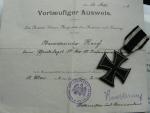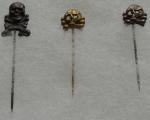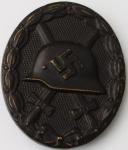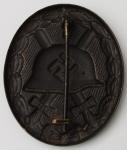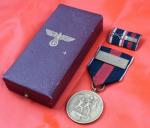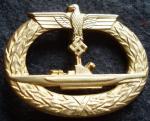-
Posts
100 -
Joined
-
Last visited
Content Type
Profiles
Forums
Blogs
Gallery
Events
Store
Everything posted by Mike Fawson
-
Hello All, Sorry for this daft question, but my memory has failed me somewhat. On a civilian button ribbon "bar" from after 1934, where you have a combination of ribbons from 1914 to 1945 - what were the rules for the order of the ribbons on the button bar? I.e. which had to be at the back and which at the front and which went in between. Thanks, Mike
-

EK 1914 WW1 EK2 document
Mike Fawson replied to Mike Fawson's topic in Germany: All Eras: The Iron Cross
Thanks Chris, Dr. Oswald Reich (who was awarded the EK2) was a Veterinary Doctor. From the other documents I have, it appears he comes from Uelzen in Saxony. I believe possible some members of his family are still in Uelzen and one is also a Veterinary Doctor. -
Hello All, I purchased a group of WW1 awards from this forum a few years ago (2009 to be precise) and have finally got round to trying to document them properly (it's been a very hectic last 5 years - no excuse I know). Anyway, I was wondering if anyone could fully decipher this EK2 document? (Sorry part of it is obscured by the EK - but that part reads "Regiment" (if I have translated it correctly)) Thanks in advance, Mike
-

Wilkinson Sword Type D British survival knife
Mike Fawson replied to Mike Fawson's topic in Swords & Edged Weapons
Thanks for the information and comments. I do also have a fairly early FS knife, but I prefer this knife - it's very functional as a bush/survival knife. The original type D's are actually becoming quite hard to find, I wouldn't say they are rare but they are now commanding prices of anything from £170 to £250. I think I paid something like £10 for this, I originally got it as a "bush" knife and used it as such - it's so solidly built you can take small trees down with it (if you have the odd half an hour to spare). Mervyn - you asked about Sark. In the summer we have a population of around 650 to 700 with all the seasonal workers, in winter the population drops to about 350 to 400. There weren't many fortifications on Sark, there were mine fields everywhere. The only real remnants of the German occupation we have are the German barbed wire fence posts (we have a couple in our garden) and the odd tunnel here and there. Guernsey, Jersey and Alderney on the other hand have masses of German fortifications. -

Wilkinson Sword Type D British survival knife
Mike Fawson replied to Mike Fawson's topic in Swords & Edged Weapons
Mervyn, here are a couple of pictures of the marks on the blade. As I said it's a Wilkinson Sword type D survival knife from the 1950's. There are no markings on the cross guard (which is usual for these from this period). I'll post some pictures tomorrow when the light is a bit better - it's actually too bright to take decent pictures today I'm certain I'm the only member of GMIC who lives on Sark - moved here 2 and a bit years ago from the West Midlands/ Welsh borders and am loving every day - it's a wonderful place Thanks, Mike -
I have had for many years (25 years or so) a Wilkinson Sword type D British Survival knife and just rediscovered it lurking in the bottom of a draw. The model I have is the 1B/4594 (with the crows foot), from what I understand these were made in the 1950's for aircrew and some say "special forces", however beyond that I cannot find very much information about the history of these knives. Can anyone provide me with anymore history about these knives? I'm particularly interested in more precisely when they were made and who they were actually issued to. Thanks, Mike
-

Heer Inf. Sturm Abzeichen
Mike Fawson replied to KDVR's topic in Germany: Third Reich: Wehrmacht Medals, Decorations & Awards
Cast you post a picture of the rear? Mike -
David the lines are there they are just not as defined. Looking more closely there are other differences - such as the lorrel leaves - but that could be "wear and tear". Below is an unmarked BWB from my collection that is almost identical to Windu's BWB - except the lines on the hand guard are more defined. Mike
-
OK, the reasons I am thinking Poellath are: - The rear setup is very similar to that used on a Poellath I used to have - the badge was not marked but came in a Poellath packet - the badge and packet appered to have been together a very long time. - The front of your WB is again very similar to the Poellath I used to have. As for the badge being early war - the materials are classic early war materials. Later badges were often made of steel or zinc. That said, brass and tombak were also used later in the war - however they were more scarce materials then. Below are some pictures of the Poellath I used to own. Mike



